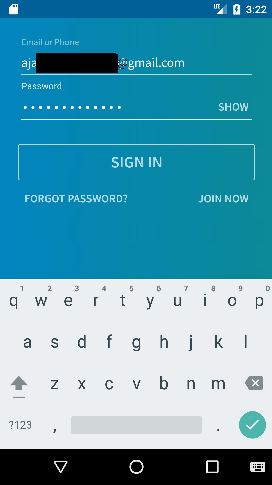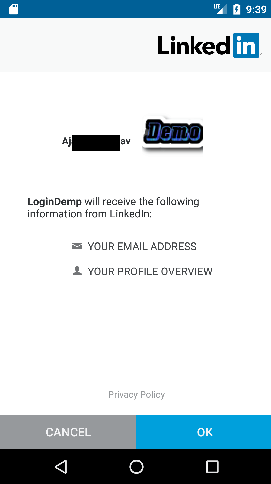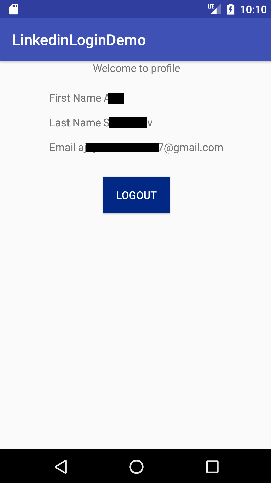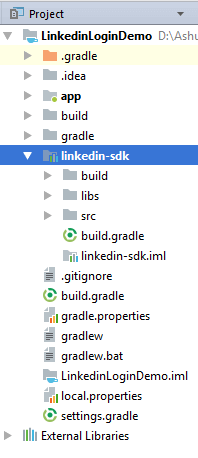Android Tutorial
Android Widgets
- UI Widgets
- Android Button
- Android Toast
- Android Custom Toast
- Android ToggleButton
- Android CheckBox
- Android Custom CheckBox
- Android RadioButton
- Android Dynamic RadioButton
- Custom RadioButton
- AlertDialog
- Spinner
- Auto Complete Text View
- ListView
- Custom ListView
- RatingBar
- WebView
- SeekBar
- DatePicker
- TimePicker
- Analog clock and Digital clock
- ProgressBar
- ScrollView Vertical
- HorizontalScrollView
- Image Switcher
- Image Slider
- ViewStub
- TabLayout
- TabLayout with FrameLayout
- SearchView
- SearchView on ToolBar
- EditText with TextWatcher
Activity and Intents
Android Fragments
Android Menu
Android Service
Android AlarmManager
Android Storage
Android SQLite
XML and JSON
Android Multimedia
Android Speech
Android Telephony
Android Device
Camera Tutorial
Sensor Tutorial
Android Graphics
Android Animation
Android Web Service
Android Examples
- QR Code / Bar Code Scanner
- RSS Feed Reader
- Volley Library Fetching JSON Data from URL
- Linkify Example
- Introduction Slider (Launch very first time when app start)
- RecyclerView List
- Swipe to Delete RecyclerView items with UNDU
- Swipe to refresh Android Activity
- Volley Library - Registration, Log-in, and Log-out
- Network Connectivity Services
- Firebase Authentication - Google Login
- Android Notification
- Using Google reCAPTCHA in Android Application
Android Social
Android Versions
Android Misc
- Android Device Manager
- Android Studio
- Android Auto
- Android to Mac
- Android Messages
- Android TV
- Android Screenshot
- Android Pay
- Android Watch
- Android Phones
- Android Tablet
- Android Find My Phone
- Android One
- Android Wear OS
- Android Data Recovery
- Android Antivirus
- Android x86
- Android Emulator for PC
- Android File Manager
- Android ad blocker
- Android Podcast App
- Fortnite Android an Epic Game
- FaceTime on Android
- ShowBox for Android
- Android App Store
- Virus Removal for Android
- cache in Android
- Root Android Device
- Android Screen Recorder
- block a number
- Canon printer app
- Wireless HP printer app
- How to Update Android
- iMessage for Android
- iCloud for Android
- Best Call Recorder
- Videoder Android
- YouTube Video Downloader
- Airdrop for Android
- RoboKiller for Android
- Clean my Android Phone
- How to hide apps, files, and photos on Android
- Best weather apps with widgets for Android
- Android File Transfer for Mac
- Mobdro for Android
- Screen Mirroring in Android
- Stock market apps for Android
- How to turn On or Off safe mode on Android
- Best browsers for Android
- Best clocks for Android
- Best email apps for Android
- Music player for Android
- Android smartwatch for women
- Best keyboard for Android
- Best messaging app for Android
Android MCQ
Android Interview
Android Quiz
Integrating LinkedIn API in Android App
In this tutorial, we will integrate the LinkedIn Sign-In functionality in our Android application. Implementing LinkedIn API in Android app helps users to login using LinkedIn account, share post, etc.
For integrating the LinkedIn API in our Android app, we need the LinkedIn Authentication Key (Client ID and Client Secret) and app Hash Key.
Steps to generate LinkedIn Authentication Key and APP Hash Key
1. Create LinkedIn developer account at https://www.linkedin.com/developer/apps and click on 'Create Application'.

2. Fill all the required details of Android application in 'Create a New Application' form and accept the LinkedIn API Terms of Use then click 'Submit'.

3. After submitting the application details, it generates LinkedIn Authentication Key. Now we will select the 'Default Application Permissions'. This permission authorizes to access privilege of user account. Here, we are selecting r_basicprofile, and 'r_emailaddress' and click 'Update'.

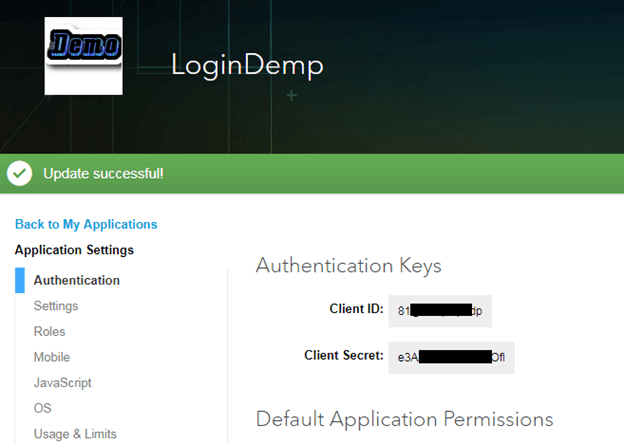
4. Now, we need the 'Hash Key' for our app. It can be generated by two different ways.
- Using command on command prompt.
Windows:
Mac/Unix
To generate the Hash Key through command prompt, it requires OpenSSL to be installed in our operating system. We can download it for Windows from www.slproweb.com/products/Win32OpenSSL.html and for Mac/Unix from http://www.openssl.org/source/ .
- Using the programming code in Activity.java class.
"Your Package Nane",
PackageManager.GET_SIGNATURES);
for (Signature signature : info.signatures) {
MessageDigest md = MessageDigest.getInstance("SHA");
md.update(signature.toByteArray());
Log.d("KeyHash:", Base64.encodeToString(md.digest(), Base64.DEFAULT));
For this application, we will use the programming code to generate 'Hash Key' for our application.
Now create our application and simply write the following code and run to generate our 'Hash Key'. It will show the application 'Hash Key' in Logcat.
MainActivity.java
import android.content.pm.PackageInfo;
import android.content.pm.PackageManager;
import android.content.pm.Signature;
import android.support.v7.app.AppCompatActivity;
import android.os.Bundle;
import android.util.Base64;
import android.util.Log;
import java.security.MessageDigest;
public class MainActivity extends AppCompatActivity {
public static final String PACKAGE = "example.com.linkedinlogindemo";
@Override
protected void onCreate(Bundle savedInstanceState) {
super.onCreate(savedInstanceState);
setContentView(R.layout.activity_main);
computePakageHash();
}
private void computePakageHash() {
try {
PackageInfo info = getPackageManager().getPackageInfo(
"example.com.linkedinlogindemo",
PackageManager.GET_SIGNATURES);
for (Signature signature : info.signatures) {
MessageDigest md = MessageDigest.getInstance("SHA");
md.update(signature.toByteArray());
Log.d("KeyHash:", Base64.encodeToString(md.digest(), Base64.DEFAULT));
}
} catch (Exception e) {
Log.e("TAG",e.getMessage());
}
}
}
5. Copy the 'Hash Key' from Logcat and paste it in Mobile tab of our LinkedIn application. After that click on 'Add' and 'Update'. This makes our application 'Hash Key' registered with LinkedIn API.
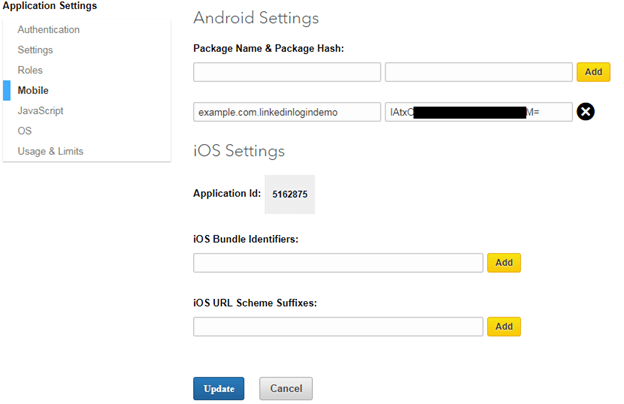
Example to Integrate LinkedIn Login in Android app
Let's create an example of integrating the LinkedIn log-in functionality in our Android application. After successful user log-in, it will redirect user to another activity (ProfileActivity) and display the user information.
We need to add the LinkedIn SDK for Android in our project. It can be downloaded from here https://developer.linkedin.com/downloads#androidsdk.
Required Permission
Add the Internet permission in AndroidMenifest.xml file.
settings.gradle
Add the linkedin-sdk in settings.gradle file.
build.gradle (Module)
Add the compile project(path: ':linkedin-sdk') in build.gradle file.
implementation fileTree(dir: 'libs', include: ['*.jar'])
implementation 'com.android.support:appcompat-v7:26.1.0'
implementation 'com.android.support.constraint:constraint-layout:1.0.2'
testImplementation 'junit:junit:4.12'
androidTestImplementation 'com.android.support.test:runner:1.0.1'
androidTestImplementation 'com.android.support.test.espresso:espresso-core:3.0.1'
compile project(path: ':linkedin-sdk')
}
activity_main.xml
Add the following code in activity_main.xml file. Download the recommended LinkedIn button from LinkedIn developer site https://developer.linkedin.com/downloads and add it as the background of button.
<RelativeLayout xmlns:android="http://schemas.android.com/apk/res/android"
xmlns:app="http://schemas.android.com/apk/res-auto"
xmlns:tools="http://schemas.android.com/tools"
android:layout_width="match_parent"
android:layout_height="match_parent"
tools:context="example.com.linkedinlogindemo.MainActivity">
<TextView
android:id="@+id/textView"
android:layout_width="wrap_content"
android:layout_height="wrap_content"
android:layout_alignParentTop="true"
android:textSize="20dp"
android:layout_centerHorizontal="true"
android:text="This is Login Page" />
<Button
android:id="@+id/login_button"
android:layout_width="wrap_content"
android:layout_height="wrap_content"
android:layout_alignParentBottom="true"
android:layout_centerHorizontal="true"
android:layout_marginBottom="17dp"
android:background="@drawable/loginbutton"
tools:layout_editor_absoluteX="58dp"
tools:layout_editor_absoluteY="437dp" />
</RelativeLayout>
MainActivity.java
In the MainActivity.java class, we use the LISessionManager class which provides all functionality to create and manage the LISession object (LinkedIn session object). In the build, scope adds the 'Scope.R_BASICPROFILE' and 'Scope.R_EMAILADDRESS' to access user basic profile information and email address of LinkedIn.
import android.content.Intent;
import android.support.v7.app.AppCompatActivity;
import android.os.Bundle;
import android.view.View;
import android.widget.Button;
import android.widget.TextView;
import android.widget.Toast;
import com.linkedin.platform.LISessionManager;
import com.linkedin.platform.errors.LIAuthError;
import com.linkedin.platform.listeners.AuthListener;
import com.linkedin.platform.utils.Scope;
public class MainActivity extends AppCompatActivity {
Button loginBtn;
TextView textView;
@Override
protected void onCreate(Bundle savedInstanceState) {
super.onCreate(savedInstanceState);
setContentView(R.layout.activity_main);
loginBtn = (Button) findViewById(R.id.login_button);
textView=(TextView)findViewById(R.id.textView);
loginBtn.setOnClickListener(new View.OnClickListener() {
@Override
public void onClick(View view) {
loginHandle();
}
});
}
public void loginHandle() {
LISessionManager.getInstance(getApplicationContext()).init(MainActivity.this, buildScope(), new AuthListener() {
@Override
public void onAuthSuccess() {
// Authentication was successful. You can now do other calls with the SDK.
Intent intent=new Intent(MainActivity.this,ProfileActivity.class);
startActivity(intent);
}
@Override
public void onAuthError(LIAuthError error) {
// Handle authentication errors
Toast.makeText(getApplicationContext(),"Login Error "+error.toString(),Toast.LENGTH_LONG).show();
}
}, true);
}
private static Scope buildScope() {
return Scope.build(Scope.R_BASICPROFILE, Scope.R_EMAILADDRESS);
}
@Override
protected void onActivityResult(int requestCode, int resultCode, Intent data) {
// Add this line to your existing onActivityResult() method
LISessionManager.getInstance(getApplicationContext()).onActivityResult(this, requestCode, resultCode, data);
}
}
activity_profile.xml
Now, add the following code in activity_profile.xml file. In this activity, we will display the user information after successful login.
<LinearLayout xmlns:android="http://schemas.android.com/apk/res/android"
xmlns:app="http://schemas.android.com/apk/res-auto"
xmlns:tools="http://schemas.android.com/tools"
android:layout_width="match_parent"
android:layout_height="match_parent"
android:orientation="vertical"
android:gravity="center_horizontal"
tools:context="example.com.linkedinlogindemo.ProfileActivity">
<TextView
android:layout_width="wrap_content"
android:layout_height="wrap_content"
android:text="Welcome to profile" />
<TextView
android:layout_width="wrap_content"
android:layout_height="wrap_content"
android:id="@+id/userDetail"
android:text="userdetail"
android:layout_marginTop="20dp"
/>
<Button
android:layout_width="wrap_content"
android:layout_height="wrap_content"
android:layout_marginTop="30dp"
android:textColor="#FFF"
android:text="logout"
android:id="@+id/logout_button"
android:background="#022885"
/>
</LinearLayout>
ProfileActivity.java
Add the LinkedIn API URL https://api.linkedin.com/v1/people/~:(id,first-name,last-name,email-address) in getRequest() method of APIHelper class. It will retrieve the user information on success of LinkedIn API.
import android.content.Intent;
import android.support.v7.app.AppCompatActivity;
import android.os.Bundle;
import android.view.View;
import android.widget.Button;
import android.widget.TextView;
import android.widget.Toast;
import com.linkedin.platform.APIHelper;
import com.linkedin.platform.LISession;
import com.linkedin.platform.LISessionManager;
import com.linkedin.platform.errors.LIApiError;
import com.linkedin.platform.listeners.ApiListener;
import com.linkedin.platform.listeners.ApiResponse;
import org.json.JSONException;
import org.json.JSONObject;
public class ProfileActivity extends AppCompatActivity {
TextView user_detail;
String firstName,lastName,userEmail;
Button logout;
@Override
protected void onCreate(Bundle savedInstanceState) {
super.onCreate(savedInstanceState);
setContentView(R.layout.activity_profile);
user_detail=(TextView)findViewById(R.id.userDetail);
logout=(Button)findViewById(R.id.logout_button);
fetchuserData();
logout.setOnClickListener(new View.OnClickListener() {
@Override
public void onClick(View view) {
LISessionManager.getInstance(getApplicationContext()).clearSession();
Toast.makeText(getApplicationContext(),"Logout Successfully",Toast.LENGTH_LONG).show();
Intent intent = new Intent(ProfileActivity.this, MainActivity.class);
startActivity(intent);
}
});
}
private void fetchuserData() {
String url = "https://api.linkedin.com/v1/people/~:(id,first-name,last-name,email-address)";
APIHelper apiHelper = APIHelper.getInstance(getApplicationContext());
apiHelper.getRequest(this, url, new ApiListener() {
@Override
public void onApiSuccess(ApiResponse apiResponse) {
// Success!
try {
JSONObject jsonObject = apiResponse.getResponseDataAsJson();
firstName = jsonObject.getString("firstName");
lastName = jsonObject.getString("lastName");
userEmail = jsonObject.getString("emailAddress");
StringBuilder stringBuilder = new StringBuilder();
stringBuilder.append("First Name " + firstName + "\n\n");
stringBuilder.append("Last Name " + lastName + "\n\n");
stringBuilder.append("Email " + userEmail);
user_detail.setText(stringBuilder);
} catch (JSONException e) {
e.printStackTrace();
}
}
@Override
public void onApiError(LIApiError liApiError) {
// Error making GET request!
Toast.makeText(getApplicationContext(),"API Error"+liApiError.toString(),Toast.LENGTH_LONG).show();
}
});
}
}
output:

